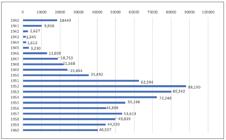Abstract
The mining villages of Arroio dos Ratos and Butiá, in Rio Grande do Sul, were, in the first half of the 20th century, two of the largest concentrations of workers in the south of Brazil. With a concentration of around 7,000 workers, the region was a leader in Brazilian coal production until the end of World War II. At the end of the conflict, even with the decrease of the product’s demand, there was great incentive to the immigration of European refugees, especially Russians, Poles, Germans, Ukrainians and others. Such context increased the concentration of nationalities and ethnicities in the villages, as well in the mechanisms for controlling the workforce, including the classification of workers as “good”, “regular” and “bad” by large mining companies. Based on previously unpublished business documentation, this study analyzes the process of “importing” workers via diplomatic and government instruments and employers’ command strategies, as well as experiences of resistance and adaptation of workers to the extremely unhealthy environment of coal mines.
Keywords:
labor; immigration; coalminers

 Thumbnail
Thumbnail
 Fonte: Elaboração própria a partir de seleção de trecho da tabela “Imigração no Brasil - 1820-1975”, publicada em VAINFAS, Ronaldo (Org.). Brasil: 500 anos de povoamento. IBGE, Centro de Documentação e Disseminação de Informações. Rio de Janeiro: IBGE, 2007, p. 225. Disponível em: <https://biblioteca.ibge.gov.br/visualizacao/livros/liv6687.pdf>. Acesso em: 10 mar. 2021.
Fonte: Elaboração própria a partir de seleção de trecho da tabela “Imigração no Brasil - 1820-1975”, publicada em VAINFAS, Ronaldo (Org.). Brasil: 500 anos de povoamento. IBGE, Centro de Documentação e Disseminação de Informações. Rio de Janeiro: IBGE, 2007, p. 225. Disponível em: <https://biblioteca.ibge.gov.br/visualizacao/livros/liv6687.pdf>. Acesso em: 10 mar. 2021.